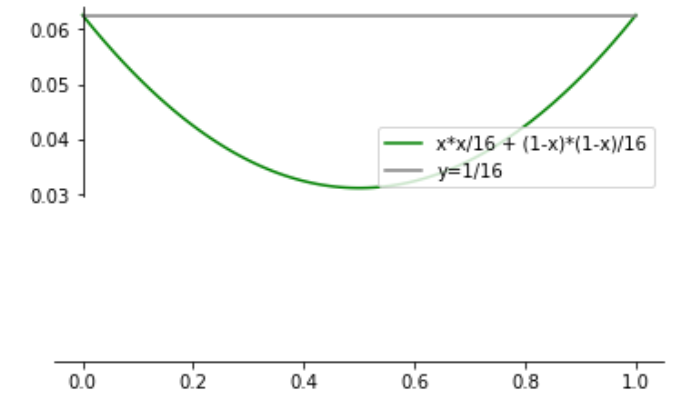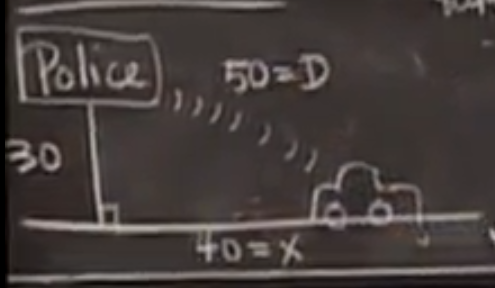The content of this article comes from learning MIT open course: univariate calculus - correlation rate - Netease open course
1, Examples of best value problems
1. Cut a line with a length of 1 into 2 segments, circle each segment into a square, and find the maximum area that can be obtained


 ,
, 
Calculate both ends:

 Therefore, when the stagnation point meets the conditions, the greater the x, the greater the value of the function. When x - > 1, the function is the largest
Therefore, when the stagnation point meets the conditions, the greater the x, the greater the value of the function. When x - > 1, the function is the largest 

 Therefore, when the stagnation point meets the conditions, the smaller x, the greater the value of the function. When X - > 0, the function is the largest
Therefore, when the stagnation point meets the conditions, the smaller x, the greater the value of the function. When X - > 0, the function is the largest 
Considering the stagnation point of high, middle and low on both sides, the minimum area value at the stagnation point is 1 / 32
from sympy import *
import numpy as np
import matplotlib.pyplot as plt
fig = plt.figure()
ax = fig.add_subplot(1, 1, 1)
ax.spines['left'].set_position('zero')
ax.spines['bottom'].set_position('zero')
ax.spines['right'].set_color('none')
ax.spines['top'].set_color('none')
ax.xaxis.set_ticks_position('bottom')
ax.yaxis.set_ticks_position('left')
ax.set_aspect(10 )
def DrawXY(xFrom,xTo,steps,expr,color,label,plt):
yarr = []
xarr = np.linspace(xFrom ,xTo, steps)
for xval in xarr:
yval = expr.subs(x,xval)
yarr.append(yval)
y_nparr = np.array(yarr)
plt.plot(xarr, y_nparr, c=color, label=label)
def TangentLine(exprY,x0Val,xVal):
diffExpr = diff(exprY)
x1,y1,xo,yo = symbols('x1 y1 xo yo')
expr = (y1-yo)/(x1-xo) - diffExpr.subs(x,x0Val)
eq = expr.subs(xo,x0Val).subs(x1,xVal).subs(yo,exprY.subs(x,x0Val))
eq1 = Eq(eq,0)
solveY = solve(eq1)
return xVal,solveY
def DrawTangentLine(exprY, x0Val,xVal1, xVal2, clr, txt):
x1,y1 = TangentLine(exprY, x0Val, xVal1)
x2,y2 = TangentLine(exprY, x0Val, xVal2)
if len(txt)>0:
plt.plot([x1,x2],[y1,y2], color = clr, label=txt)
else:
plt.plot([x1,x2],[y1,y2], color = clr)
x= symbols('x')
y = x*x/16 + (1-x)*(1-x)/16
DrawXY(0,1,100,y,'green','x*x/16 + (1-x)*(1-x)/16',plt)
plt.plot([0,1],[1/16,1/16], color = 'gray', label= 'y=1/16')
plt.legend(loc='lower right')
plt.show()

2. Find a box with a fixed volume without a top cover and minimize its surface area. (tip: the bottom is a square - because the perimeter of a square is the shortest)

Here y can be called constraint, 
 (no top)
(no top)

A' = 0



 (stagnation point)
(stagnation point)
Endpoint 


Because the stagnation point is  So the picture should be
So the picture should be

Consider the second derivative
 (from x > 0, the formula is always positive, so the figure should be concave, and the stagnation point should be the minimum point)
(from x > 0, the formula is always positive, so the figure should be concave, and the stagnation point should be the minimum point)
The optimal solution is: 
 (my answer is different from that in the video...)
(my answer is different from that in the video...)
These ratios are meaningful only with dimensionless solutions, and the units need to be unified:
 (my answer is different from that in the video...)
(my answer is different from that in the video...)
 So the best solution for making a box is that the ratio of the bottom edge to the height is 2
So the best solution for making a box is that the ratio of the bottom edge to the height is 2
3. Implicit function derivation method
 , V is a fixed value
, V is a fixed value
 (no top), minimum required
(no top), minimum required
Because y is a function of x,





It is understood quickly, but it is impossible to check whether the solution is the maximum, minimum or stagnation point
For this problem, only one method can be used to calculate the boundary, but the teacher said that in real life, many formulas can easily see the boundary and so on, so it is easy to distinguish whether this solution is needed
2, Correlation rate
1. There's a policeman, 30 feet from the road. You drive here. The police have a radar and are measuring the speed. The radar shows a distance of 50 feet from you, and your car is approaching at 80 feet per second in the direction of the radar. Speeding 95 feet per second, 65 miles per hour. The question is, are you speeding?

Note: the distance from the car to the vertical foot of the straight line on the figure changes, so the distance is x. at the same time, the distance between the car and the police also changes, set it as D, and the time change is set as t. here is mainly the calculation  .
.